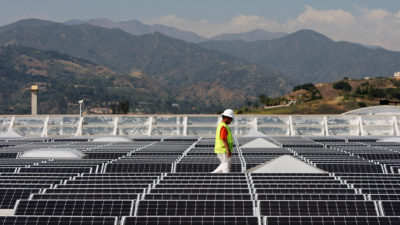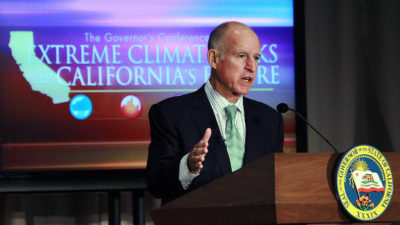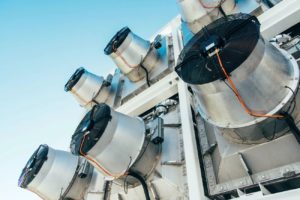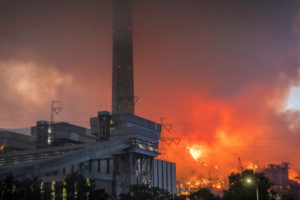作为环境标准者和绿色技术先驱,没有其他州的加利福尼亚州竞争对手。
更多的than two decades before the U.S. Congress passed the Clean Air Act, California became the first state to enact air pollution legislation, in 1947. The state’s Air Resources Board, widely considered the most powerful air pollution regulatory agency in the world, has used its authority to prod hybrid and electric cars into widespread commercial use. Spurred by the nation’s strongest and most innovative building code, new buildings in California now useabout 75 percent less energy比预制建筑物,以及节省了足够的能量迈出相当于七个500兆瓦的天然气发电厂的建设。
California is the only state with its own greenhouse gas emissions cap-and-trade program, which earned it about25亿美元的收入从去年的排放许可中获得。该州以其蓬勃发展的硅谷技术行业为首,领导该国为电动和自动驾驶汽车和“智能”电网发明发明,这有助于创造基于可再生能源的经济。
“加利福尼亚作为探路者的重要角色,探索了能源过渡,气候变化和环境的过程,”落基山研究所, a Colorado-based energy think tank.
所有这些使该州与唐纳德·J·特朗普总统的碰撞课程进行了碰撞,后者通过他的陈述和任命明确表示,他准备无视气候变化和压力化石燃料的威胁,这是实现强劲经济增长的道路。作为回应,加利福尼亚州的所有民主党人都表示反抗。
“We’ve got the scientists, we’ve got the lawyers, and we’re ready to fight,” Governor Jerry Brown proclaimed at a meeting of the American Geophysical Union in San Francisco in December. Then, referring to Trump administration threats to cut funding for climate change research,Brown said, “If Trump turns off the satellites, California will launch its own damn satellite!”
California Governor Jerry Brown speaks at the Governor's Conference on Extreme Climate Risks and California's Future in December 2011.贾斯汀·沙利文/盖蒂图像
What’s at stake in this face-off is California’s ability to maintain its own relatively rigorous environmental laws and regulations as the Trump administration loosens environmental provisions at the federal level. Implicit in the battle is a striking reversal of roles, in which environmentalists who once championed federal power over states now support states’ rights, while Trump appointees who once argued for states’ rights consider how to squelch California’s renegades. Neither side is likely to emerge with an all-out victory: While the Trump administration may use budget cuts, deregulation, and legislative pruning to box in the state, experts say, it has no way to prevent California from continuing on an independent path in key environmental domains.
As it happens, many California environmentalists regard the environmental record of their new de facto spokesman, Governor Brown, as mixed, largely because of his support for fracking — the state is the nation’s fourth-largest oil producer — and water projects that benefit agricultural interests at the expense of rivers and estuaries. Nevertheless, they welcome his emergence as the Democrats’ leading advocate for responsible climate change policies. “I think Jerry Brown is genuinely interested in environmental protection, and I think he will be a leader in pushing back the assault on environmental policies,” said Gary Bobker, director of the rivers and delta program at the San Francisco-based湾研究所.
Last month, the state legislature hired Eric Holder, President Barack Obama’s attorney general from 2009 to 2015, to represent it in expected legal battles against the Trump administration. California now seems poised to play the role that Texas performed during the Obama administration, when Texas sued the federal government at least 48 times. More than half of those suits dealt with climate change and air and water quality. “I go into the office, I sue the federal government, and I go home,” then-Texas attorney general and now-governor Greg Abbott famously said in 2013. California’s attorney general, Xavier Becerra, who was appointed by Brown last month, sounded distinctly Abbott-like in astatement he directed at Trumpin December: “If you want to take on a forward-leaning state that is prepared to defend its rights and interests, then come at us.”
California’s policies drive technological change in the transportation sector, not just nationally, but internationally.
The Trump administration’s greatest point of leverage against California’s environmental policies is the air pollution waiver given to the state in the 1970 Clean Air Act. The waiver acknowledged the state’s severe smog problem and the precedent-setting car emissions regulations California devised to reduce air pollution by allowing the state to establish more stringent standards than the federal government’s. Since then, a dozen other states have agreed to follow California’s emissions policies, which means that about 40 percent of American cars are covered by its rules. That number is so large that car manufacturers generally design all their vehicles to meet California standards instead of producing one model for California regulations and another for federal ones. The result is that California’s policies drive technological change in the transportation sector, not just nationally, but internationally.
从1969年的模型年开始,联邦政府已授予加利福尼亚州的新车辆排放标准豁免一百以上,无论哪个政党占领白宫。但是,特朗普在上个月确认听证会上,特朗普新的环境保护署新任管理员的声明表明,加利福尼亚的豁免处于危险之中。普鲁伊特(Pruitt)受到加利福尼亚州参议员卡马拉·哈里斯(Kamala Harris)致力于维护豁免的邀请,相反,他“不想假设对政策进行审查的结果”。鉴于俄克拉荷马州的总检察长始于2010年,他是国家权利的倡导者,甚至建立了反对联邦能源和环境法的“联邦制”部门,他拒绝认可豁免特别令人惊讶。
如果普鲁伊特(Pruitt)决定撤销加利福尼亚州现有的豁免,该豁免涵盖了到2025年制造的所有车辆,他将不得不说加利福尼亚无需调节温室气体排放,这几乎可以肯定会引发一场长期的法律斗争。普鲁伊特(Pruitt)避免这样的战斗的唯一方法是说服国会首先撤销《清洁空气法》的规定,该法案首先确立了该州的豁免权。鉴于共和党对现任国会的统治,这种变化肯定是可以想象的,尽管它会遇到挑剔的民主党人,甚至可能是某些共和党人的抵抗。
特朗普政府还可以抓住它反对的加利福尼亚政策,例如该州反对移民驱逐出境,以证明将联邦资金削减向该州进行辩护,从而造成预算危机,这将阻碍加利福尼亚的雄心勃勃的能源计划。特朗普在本月早些时候威胁到此类削减,以应对拟议的州立法,禁止州和地方执法人员维护联邦移民法。“如果需要的话,我们会退还。”told Fox News采访者比尔·奥赖利(Bill O’Reilly)。“我们向加利福尼亚付出了巨大的钱。加利福尼亚在许多方面都是失控的。”但是,使用这种钝武器来惩罚国家可能威胁加利福尼亚州的经济,这是世界第六大的经济,并可能阻碍特朗普承诺将实现其政策的巨大经济扩张。
The Trump administration could hamstring California’s energy programs by cutting funding for a broad range of federal energy programs that support national laboratories, universities, and private companies. If, for example, the U.S. Department of Energy decides to cut funding for energy efficiency, California’s劳伦斯·伯克利国家专注于节能技术的实验室可能很容易受到伤害。或政府可以削减能源部的贷款担保计划,该计划以资助失败的太阳能公司Solyndra而闻名,但也可以在许多其他公司的成功中发挥了重要作用,包括特斯拉,电动汽车和储能制造商在Palo Alto。
政府还可以减少或消除可再生能源的联邦税收抵免体系,但这将有可能受益于许多共和党控制的国家的反对。爱荷华州的共和党参议员查克·格拉斯利(Chuck Grassley)去年表示,如果特朗普试图削减风能税收抵免,“他会在我的尸体上做到这一点。”爱荷华州从风力发电中产生了其三分之一的电力,是美国第三大风能发电机。加利福尼亚是第二。
‘每个人都在谈论红色州和蓝色国家。我们必须开始谈论绿色州和棕色国家。’
Iowa’s example indicates the obstacles the Trump administration could encounter if it tries to weaken support for renewable energy. “Everyone talks about red states and blue states,” said Hal Harvey, CEO of活力Innovation,位于旧金山的政策研究小组。“我们确实必须开始谈论绿色国家和棕色国家。大约有十二个州”(其中许多国家都在共和党控制中 - 具有非常强大的可再生投资组合标准和非常强大的公用事业能源效率计划,公用事业将成为建造电动汽车充电基础设施的主要推动者。”
California’s cap-and-trade program, presumably a lightning rod for the Trump administration’s disapproval, faces no threat from the federal government, since it is not dependent on federal approval. On the other hand, a lawsuit brought in 2012 by the California Chamber of Commerce has put the program in some jeopardy. The suit argues that the program’s fees amount to taxes, and according to state law, tax provisions must be passed by a two-thirds majority of the legislature, a threshold the cap-and-trade legislation did not meet. But Democrats currently enjoy two-thirds majorities in both the state Senate and Assembly, and so could likely meet the tax vote requirement with new legislation.
在大多数其他方面,无论特朗普政府的行动如何,加利福尼亚州和其他州都可以执行其环境和能源政策。这部分是因为传统上是国家的核心,它是清洁能源过渡的核心,而不是联邦政府的控制。正如自然资源辩护委员会能源计划的联合主任拉尔夫·卡瓦纳(Ralph Cavanagh)解释说:“可再生能源,能源效率和当今美国最重要的气候政策解决方案是国家官员的授权。清洁能源的资本投资并非来自联邦政府,它来自公共和投资者拥有的公用事业的预算。”
也许最值得注意的是,加利福尼亚将能够继续其雄心勃勃的温室气体排放道路。美国全球变暖解决方案法of 2006, signed into law by a Republican governor, Arnold Schwarzenegger, set in place regulations and market mechanisms to lower California’s emissions to 1990 levels by 2020. Not only is the state on schedule to meet that goal, but last year the legislature approved a new, far tougher target, requiring an additional 40 percent cut below 1990 levels by 2030.
加利福尼亚正在重组其电网,并已成为开发可再生能源的测试场。
最重要的是,该州正在对其电网进行开创性的重组,并在此过程中已成为开发可再生能源的测试基础。The California Public Utilities Commission has directed the state’s utilities to develop demonstration projects with smaller companies that use local energy resources such as rooftop solar, batteries, and smart water heaters and thermostats, thereby avoiding the need for major infrastructure investments in things like new substations and transmission lines.
该州还将其电网市场扩展到邻国,以提高生产力过剩的时期网格的灵活性。例如,当人们下班回家时,亚利桑那州的每日电力需求增加,这是加州可能会出售给亚利桑那州的可再生能源过多的时期。由于太阳在两个州的不同时间落山,因此亚利桑那州(一天结束的末日)的高峰电力需求可能与加利福尼亚州(一天中期)的太阳能生产峰值重叠。
Even as California faces regulatory headwinds from the Trump administration, it is riding strong economic and technological tailwinds that favor its goals of weaning its economy off fossil fuels. The administration seems bent on one last lucrative gulp at the fossil fuel trough. But as climate change intensifies, the desirability of fossil fuel use probably will continue to decline, and in any case, the steadily dropping cost of renewable energy will make it increasingly likely that wind energy, solar power, and other renewables will gradually supplant fossil fuels. In that case, California will be in prime position to reap the benefits of its policies.




